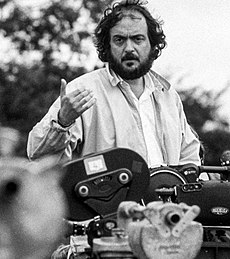Roger's reviews have appeared in McClatchy-Tribune
News Service, Orlando Sentinel, Spin Magazine, The World,
Orlando Magazine Autoweek Magazine among others. He is
the founder and editor of Movie
Nation
I
submit that even at this late date, with director Stanley
Kubrick long parked near the top of the cinematic pantheon,
that we’re allowed to watch at least the first 20 minutes
of the first jewel in his crown, The Killing, thinking
“this isn’t all that.”
Voice-over
narration, the crutch of many a hack and the bane of “let
the pictures tell the story” guys like Kubrick, over-explains
and dumbs down the movie to an almost irredeemable degree.
It was added over Kubrick’s objections.
 The
tropes of many a gangster movie and heist picture —
assembling the team (a collection of heavies), machine gun
in a violin case and later tucked into a delivery box of long-stemmed
roses — are trotted out. It’s only on reflection
that we wonder if Kubrick wasn’t the first to think
of the flower box bit and other touches, way back in 1955.
The
tropes of many a gangster movie and heist picture —
assembling the team (a collection of heavies), machine gun
in a violin case and later tucked into a delivery box of long-stemmed
roses — are trotted out. It’s only on reflection
that we wonder if Kubrick wasn’t the first to think
of the flower box bit and other touches, way back in 1955.
The
folding-in of second unit racetrack and stock footage isn’t
seamlessly handled and the multiple points-of-view versions
of the heist — a $2 million robbery at a California
horse track — has a clumbsiness about it that others
(Tarantino in Reservoir Dogs) managed to improve
on.
But
about 20 minutes in, when race track cashier George, played
by the iconic ‘little man’ of many a crime drama
Elisha Cook Jr., gets slapped around because his greedy, unfaithful
wife (Marie Windsor) has been caught eavesdropping on the
gang’s plans, The Killing takes off, pulls
us in and earns its reputation as an inspiration to generations
and the landmark thriller it is seen as today.
Classic films are always overwhelmed by their legend and the
details-cluttered back-story of how they got made. Skipping
over all that, ignoring the whole Rodney Dangerfield ‘cameo’
in the brawl scene and the first of Kubrick’s uses of
actor Joe Turkel, the simple evidence of what’s on the
screen still holds the eye and fires the imagination.
Casting
a genuine he-man among Hollywood’s movie stars, Sterling
Hayden, pays the flintiest of dividends. As Johnny, fresh
out of Alcatraz, he’s believably pitiless about abusing
men in the gang, and women, and plotting a heist that depends
on a strongman chess player he knows (Kola Kwariani) busting
up a bar and getting arrested and an ex-military sniper (Timothy
Carey, superb) killing a prized racehorse to throw a race’s
results into turmoil and buy the time necessary to empty the
safe in the cash counting room.
Kubrick
populated his picture with mugs straight out of Hollywood’s
‘hard boiled’ character actor collection —
faces like Jay C. Flippen, Cooke and Ted de Corsia (playing
a crooked cop).
The
women (Windsor and Colleen Gray as Johnny’s girl) are
merely stock types, but leave impressions.
And
the heist itself, with a couple of track insiders in on the
deal, a lot of moving parts dependent on precise timing, is
still a clockwork marvel, even if it doesn’t hold up
to intense scrutiny.
You
don’t have to be a Room 237 level Kubrick fanatic
to pick up on the filmmaker’s attention to detail, his
growing obsession with mise-en-scene, often masquerading as
carelessness.
I
mean, even in 1955 a hulking tough (Hayden) seen toting a
violin case would raise a made-man eyebrow. Your Turturro-vulpine
sharpshooter is the most conspicuous guy at the track, driving
a two-tone MG-TD roadster with a showy Jaguar hood-ornament,
and doing the shooting from the seat of the roadster. Let’s
not fret too much over that omnipotent shotgun wielded by
rival robber Vince Edwards.
And
$2 million in mostly $10 and $20 bills? That would weigh over
500 pounds. Your strong-man starting the bar fight would have
been the only one with a prayer of toting it, with or without
the battered suitcase Johnny deems appropriate to hold the
loot.
But
the harsh, ugly exteriors and low-light interiors and brooding
shadows in screen veteran Lucien Ballard’s cinematography
(True Grit, The Wild Bunch, The Getaway) set the
tone.
Lapdogs
as foreshadowing, a femme fatale, “nobody knows what
anybody else” has to do with their scheme, a little
moment of cross-racial understanding in the track parking
lot (James Edwards plays the attendant) that will be Nikki
the shooter’s undoing — for an 85 minute genre
picture that United Artists basically abandoned, there’s
a lot to chew on here.
That’s
what’s always been the great appeal of burrowing into
The Cinema of Stanley Kubrick (the first book of
film criticism and scholarship I ever bought, followed by
Alexander Walker’s Kubrick tome). There’s minutia
here, details that have long attracted chess obsessives, literary
deconstructionists, coin, stamp or comic book collection ‘completists’
and the like.
The movies may have their miscalculations and flaws, like
the cinema of Welles, Ford, Bigelow and Lee. But taken as
a whole, they’re an insight into an artist’s thought
processes and obsessions, even the misfires.
I
used to think Kubrick was a filmmaker film fans matured out
of, like heavy metal, Marvel comics or a devotion to the works
of Ayn Rand. OK, I still think that to some degree.
But
his classic films are aging better than most, even the weakest
links are worth knowing, inside-and-out, because of all the
filmmakers who followed who imitate him, worship him and,
as artists, pound the same nail, over and over again.